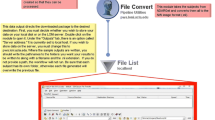Abstract
The National Database for Autism Research (NDAR) is a secure research data repository designed to promote scientific data sharing and collaboration among autism spectrum disorder investigators. The goal of the project is to accelerate scientific discovery through data sharing, data harmonization, and the reporting of research results. Data from over 25,000 research participants are available to qualified investigators through the NDAR portal. Summary information about the available data is available to everyone through that portal.

Similar content being viewed by others
References
Belmonte, M. K., Mazziotta, J. C., et al. (2008). Offering to share: how to put heads together in autism neuroimaging. Journal of Autism and Developmental Disorders, 38(1), 2–13.
Bidgood, W. D., Horii, S. C., et al. (1997). Understanding and using DICOM, the Data Interchange Standard for Biomedical Imaging. Journal of the American Medical Informatics Association, 4(3), 199–212.
Bjaalie, J. G. (2008). Understanding the brain through neuroinformatics. Frontiers in Neuroscience, 2(1), 19–21.
Brain Development Cooperative Group, & Evans, A. C. (2006). The NIH MRI Study of normal brain development. NeuroImage, 30, 184–202.
Chen, R., Jaio, Y., & Herskovits, E. H. (2011). Structural MRI in autism spectrum disorder. Pediatric Research, 69(5 Pt 2), 63R–68R.
Cox, R. W., Ashburner, J., et al. (2004). A (Sort of) new image data format standard: NifTI-1. Abstrace, 10th Annual Meeting of the Organization for Human Brain Mapping, June 13–17, Budapest, Hungary.
Evans, A. E., & the Brain Development Cooperative Group. (2006). The NIH MRI Study of Normal Brain Development. NeuroImage, 30(1), 184–202.
Fernald, G. H., Capriotti, E., et al. (2011). Bioinformatics challenges for personalized medicine. Bioinformatics, 27(13), 1741–1748.
Fischbach, G. D., & Lord, C. (2010). The Simons Simplex Collection: a resource for identification of autism genetic risk factors. Neuron, 68, 192–195.
Friedman, L., Glover, G. H., et al. (2006). Reducing interscanner variability of activation in an multicenter fMRI Study: controlling for Signal-to-Fluctuation-Noise-Ratio (SFNR) differences. NeuroImage, 33(2), 471–481.
Gorrindo, P., Williams, K. C., et al. (2012). Gastrointestinal dysfunction in autism: parental report, clinical evaluation, and associated factors. Autism Research, 5(2), 101–108.
Haroutunian, V., & Pickett, J. (2007). Autism brain tissue banking. Brain Pathology, 17(4), 412–421.
Huerta, M. F., & Koslow, S. H. (1996). Neuroinformatics: opportunities across disciplinary and national borders. NeuroImage, 4(3), S4–S6.
Huerta, M. F., Liu, Y., et al. (2006). A view of the digital landscape for neuroscience at NIH. Neuroinformatics, 4(2), 131–137.
Johnson, S. B., Whitney, G., et al. (2010). Using global unique identifiers to link autism collections. Journal of the American Medical Informatics Association, 17(6), 689–695.
Kasari, C., & Lawton, K. (2010). New directions in behavioral treatment of autism spectrum disorders. Current Opinion in Neurology, 23(2), 137–143.
Lajonchere, C. M., & the AGRE Consortium. (2010). Changing the landscape of autism research: the autism genetic resource exchange. Neuron, 68, 187–191.
Law, M. Y. Y., & Liu, B. (2009). DICOM-RT and its utilization in radiation therapy. Radiographics, 29(3), 655–667.
MacKenzie-Graham, A. J., Van Horn, J. D., et al. (2008). Provenance in neuroimaging. NeuroImage, 42(1), 178–195.
McAuliffe, M. J., Lalonde, F. M., et al. (2001). Medical image processing, analysis & visualization in clinical research. 14th IEEE Symposium on Computer-Based Medical Systems (CBMS), 381–386.
McPheeters, M. L., Warren, Z., et al. (2011). A systematic review of medical treatments for children with autism spectrum disorders. Pediatrics, 127(5), e1312–e1321.
Milham, M. P. (2012). Open neuroscience solutions for the connectome-wide association era. Neuron, 73(2), 214–218.
Mortamet, B., Bernstein, M. A., et al. (2009). Automatic quality assessment in structural brain magnetic resonance imaging. Magnetic Resonance in Medicine, 62(2), 365–372.
Patel, V., Dinov, I. D., et al. (2010). LONI MiND: metadata in NIfTI for DWI. NeuroImage, 51(2), 665–676.
Penagarikano, O., Abrahams, B. S., et al. (2011). Absence of CNTNAP2 leads to epilepsy, neuronal migration abnormalities, and core autism-related deficits. Cell, 147(1), 235–246.
Sansone, S. M., Widaman, K. F., et al. (2011). Psychometric study of the aberrant behavior checklist in fragile X syndrome and implications for targeted treatment. Journal of Autism and Developmental Disorders. doi:10.1007/s10803-011-1370-2.
Scherer, S. W., & Dawson, G. (2011). Risk factors for autism: translating genomic discoveries into diagnostics. Human Genetics, 130(1), 123–148.
Van Horn, J. D., & Ball, C. A. (2008). Domain-specific data sharing in neuroscience: what do we have to learn from each other? Neuroinform., 6(2), 117–121.
Weiner, M. W., Aisne, P. S., et al. (2010). The Alzheimer’s Disease neuroimaging initiative: progress report and future plans. Alzheimer’s & Dementia, 6(3), 202–211.
Author information
Authors and Affiliations
Corresponding author
Rights and permissions
About this article
Cite this article
Hall, D., Huerta, M.F., McAuliffe, M.J. et al. Sharing Heterogeneous Data: The National Database for Autism Research. Neuroinform 10, 331–339 (2012). https://doi.org/10.1007/s12021-012-9151-4
Published:
Issue Date:
DOI: https://doi.org/10.1007/s12021-012-9151-4




